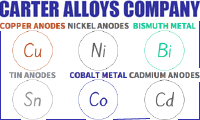
-----
Inconsistent Copper Hardness
2005
We plate hard copper on to Mild Steel cylinders so we can electromechanically engrave them and fulfill our requirements for rotogravure printing. Lately we have been experiencing inconsistent hardness in our plated hard copper which hampers engraving and eventually shows up in print results. We carry out analysis of the electrolyte on regular basis and try to maintain the composition under limits. We carry out analysis to check chlorides contents as well for which we use volumetric method (titration). When the hardness drops we in order to bring it back to required level pump in more hardener but then the copper becomes brittle and breaks in the first bend while performing the bend test. We use Ballard skin on the cylinders before final plating. Parameters used are as under;
Base material: Mild Steel.
Base plating: Cyanide copper.
Cu layer thickness: 250 to 300 microns.
Cu hardness desired: 200 205 HV.
Tank volume: 1500 ltr (both tanks)
Temperature: 30 C
Current density: 25 amp/dm2
Electrolyte composition: TANK#1 TANK#2
Cu: 230 gm/l 230 gm/l
H2SO4: 60 gm/l 60 gm/l
Chlorides: 1-2 ppm 1-2 ppm
Hardener dosing: 105 ml/l 200 ml/l
We usually do not plate base copper (this is not the flash copper) prior to final layer of hard copper, can someone shed some light whether it makes any difference or not.
I would appreciate it if someone could suggest some thing or point out if we are making any mistake in the process.
Thanks in advance,
plating shop employee - Gujrat, Punjab, Pakistan
Hello,
Can you tell us which hardening additive you're using? Some hardening additives in rotogravure Industries do not accept any chloride and it will result in brittle deposits and the hardening effect is going to be lost.
In rotogravure Industries it is also important what kind of copper anodes you're using, please check it with your supplier. The copper sulphate
⇦ on
eBay or
Amazon [affil link] is in the range, the sulfuric acid is a little bit low.
How high is your voltage during coppering process? Are the cylinders shiny? Any pores?
best regards,
- Mexico City, Mexico
2005
adv.: Supplier of Copper Anodes, Nickel Anodes, Bismuth Metal, & Other Metal Products for Industry & The Arts

Q, A, or Comment on THIS thread -or- Start a NEW Thread